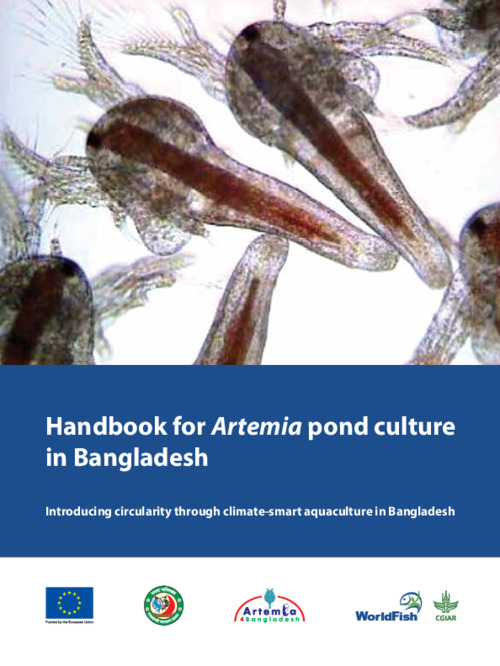Handbook for Artemia Pond Culture in Bangladesh

Brine shrimp Artemia nauplii constitute the most widely used live-food item for the larviculture of crustaceans and fish. The advantages of Artemia nauplii compared to inert diets are size (450 µm), live prey, digestibility, and high nutritional content in terms of protein and highly unsaturated fatty acids. Annually, about 3500 MT of Artemia cysts are marketed worldwide. The unique property of this small branchiopod crustacean Artemia to form dormant embryos, so-called 'cysts'. The cysts are available year-round in large quantities along the shorelines of hypersaline lakes, coastal lagoons and solar salt works scattered over the four continents. At present, Bangladesh imports 40-50 metric tons dry Artemia cysts annually worth an approximate value of USD 4 million (M. Rahman, sourced at shrimp hatcheries). Many countries in the world for example Thailand and Vietnam have successfully adopted technologies for Artemia production in solar salt farms. The aim of this manual is to provide technological guidelines to the extension agents, young researchers, salt farmers on Artemia production in salt farms in Cox’s Bazar. The manual was prepared through review recent of activities in Artemia production, the 1996 FAO Manual on the production and use of live food for aquaculture, the 2019 book “ Principle of Artemia culture in solar salt works”, relevant books
and published research articles. The manual covers (i) biology and ecology of Artemia, (ii) cyst biology and physiology during hatching process (iii) factors to consider in proper site selection, (iv) different models of
Artemia culture, (v) steps in proper pond construction, (vi) procedure in shortening the duration of Artemia pond preparation through application of concentrated sea water or crude salt, (vii) standard method of Artemia cyst incubation and stocking, (viii) Artemia pond maintenance and management, (ix) suitable algae production for feeding Artemia, (x) preparation of processed feed and supplementary feeding, (xi) diseases and health management and (xii) Artemia cyst and biomass harvesting, processing and preservation. Earlier studies described limited knowledge, improper pond management, and climatic conditions as bottleneck in for dissemination of Artemia production in salt farms. Recent improvement in Artemia production include deepening ponds more than 50 cm water depth, stocking density of 100 nauplii per litre, stimulate growth of suitable algae species (diatom, green algae), optimum supplementary feeding of green water with fermented agricultural waste products (molasses, mono sodium glutamate by-products), use of formulated shrimp feed, improvement of routine pond management such as raking of pond bottom, health management through application of bioflocs.
Permalink
Date Available
Type
Publisher
Countries
Copyright
Copyrighted; all rights reserved
Research Themes
Topics
Language